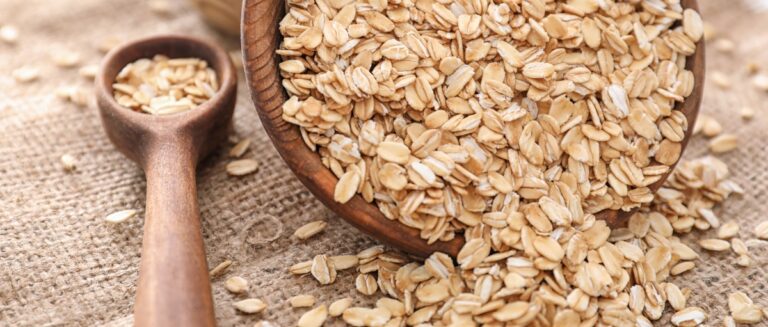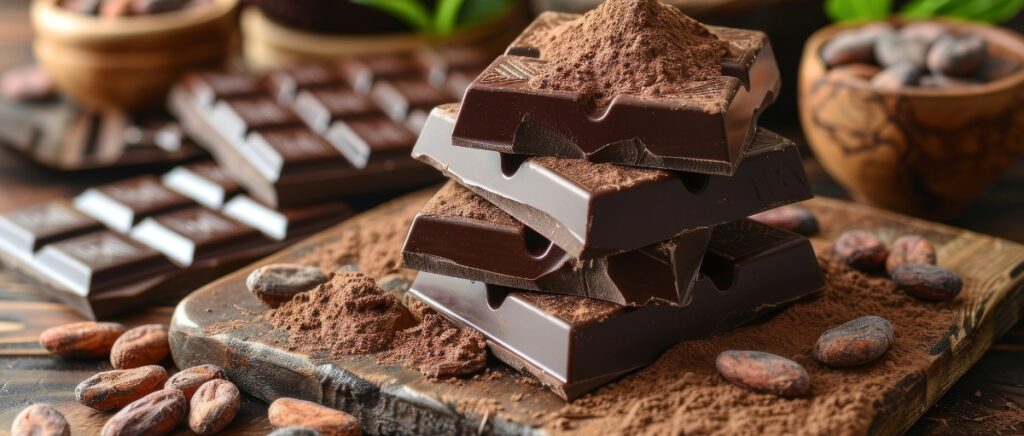Did you know that the average American consumes more than 12 pounds of chocolate yearly? That’s a lot of candy bars, truffles, and sneaky nibbles of baking chocolate! But what if we told you that your chocolate habit might not be so bad after all—in fact, it could even be good for you?
That’s right, chocolate lovers: emerging research suggests that cacao can offer impressive health benefits, from boosting brain power to protecting your heart. The key is choosing the right kind of chocolate and enjoying it in moderation as part of a balanced diet.
Let’s look at the science-backed ways chocolate can benefit you and show you how to select the most nutritious options. Plus, we’ve got plenty of fun ideas for incorporating healthy chocolate into your day.
The Truth Behind Healthy Cholocate
Chocolate, particularly dark chocolate, can be considered healthy due to its high content of cacao, which is rich in antioxidants and flavonoids. These compounds are associated with various health benefits, including:
- Improved Cardiovascular Health: Cacao’s flavonoids may help improve blood flow, lower blood pressure, and reduce “bad” cholesterol levels, decreasing the risk of heart disease.
- Antioxidant Properties: Dark chocolate contains antioxidants that neutralize free radicals, reducing oxidative stress and inflammation.
- Enhanced Brain Function: Dark chocolate’s flavonoids can improve cognitive function and mood, potentially reducing stress levels.
- Reduced Insulin Resistance: Consuming dark chocolate may improve insulin sensitivity, which is beneficial for managing diabetes.
How to Choose Healthy Cholocate (and Not Sugary Chocolate)
To choose chocolate that offers these benefits and isn’t just sugar-laden, consider the following tips:
- Cacao Content: Opt for dark chocolate with at least 70% cacao. Higher cacao content generally means more flavonoids and less sugar.
- Check Ingredients: Ensure that cocoa beans or cacao mass are listed as the first ingredient, and avoid chocolates with added vegetable oils, peanut butter (which is prone to go rancid), or artificial sweeteners.
- Avoid Alkalized Chocolate: This process, also known as dutching, reduces the antioxidant content. Look for labels that don’t mention “processed with alkali.”
- Minimize Sugar: Compare nutrition labels to find chocolate with lower sugar, especially from refined sources. Dark chocolate typically has less sugar than milk chocolate.
- Moderation: Despite its benefits, dark chocolate is calorie-dense, so it should be consumed in moderation to avoid weight gain.
3 Reasons to Eat More Dark Cholocate
Milk chocolate doesn’t have the same nutrition profile as a single-source 70%+ dark chocolate bar. Here are three great reasons to start sourcing better, darker chocolate.
1. Antioxidants for Whole-Body Health
Cacao is packed with antioxidants, which help neutralize harmful free radicals in the body. Free radicals can damage cells and contribute to chronic inflammation, a cause of many diseases. By fighting free radicals, the antioxidants in chocolate may help lower your risk of conditions like heart disease, diabetes, and even certain cancers.
Cacao has an incredibly high antioxidant content compared to other plant foods. A landmark 2011 study found that cacao had more antioxidant activity than superfoods like acai berries and blueberries!
2. Flavanols for Heart and Brain Health
Cacao is also rich in flavanols, a type of antioxidant that is especially beneficial for heart and brain health. Studies suggest that the flavanols in cacao may help:
- Lower blood pressure
- Improve blood flow to the heart and brain
- Reduce inflammation
- Support healthy cholesterol levels
One review of 19 studies found that people who regularly consumed flavanol-rich chocolate had a lower risk of heart disease and stroke compared to those who ate less. A 2022 study linked daily flavanol intake to better memory and attention in older adults.
3. A Natural Mood-Booster
Chocolate’s benefits go beyond the body—this treat is also good for the soul! Enjoying chocolate stimulates the release of feel-good chemicals like serotonin and dopamine in the brain. This may be why many people find that chocolate lifts their spirits and helps them feel more relaxed.
The mood-boosting effects of chocolate may even have a biological basis. One study found that participants who consumed high-flavanol cocoa powder reported significantly greater calmness and contentment than those who consumed low-flavanol cocoa.
How Much Chocolate Should You Eat?
While the health benefits of chocolate are exciting, it’s important to enjoy it in moderation as part of a balanced diet. Nutrition experts recommend sticking to 1 to 2 ounces of dark chocolate daily—about one to two to four squares, depending on the bar.
That means you shouldn’t feel guilty about savoring a small piece of high-quality chocolate as an afternoon pick-me-up or after-dinner treat. Just be sure to balance it with other nutrient-dense whole foods, like fruits, vegetables, nuts, and seeds.
How to Choose Chocolate That’s Actually Good for You
Walk down any grocery store’s candy aisle and see a dizzying array of chocolate options. However, not all chocolates are created equal in terms of health benefits. Here’s what to look for to ensure your chocolate habit supports your wellness goals:
Choose Chocolate with 70% Cacao or Higher.
The percentage on a chocolate bar refers to how much of the bar, by weight, comes from cacao beans. The higher the percentage, the more cacao the bar contains, thus the more beneficial flavanols and antioxidants.
To maximize the health benefits, choose dark chocolate with at least 70% cacao. Milk chocolate, which has more added sugar and dairy, typically contains much lower amounts of cacao—sometimes as little as 10%.
Read Labels Carefully
Even if a “healthy” chocolate bar boasts a high cacao percentage, it may still contain unhealthy ingredients that cancel out the health benefits. When buying chocolate, watch out for:
- High amounts of added sugars: Chocolate bars that list sugar as the first ingredient tend to be less healthy than those with cacao or cocoa beans listed first. Aim for bars with no more than 10 grams of added sugar per serving.
- Artificial flavors and preservatives: Avoid chocolate with unpronounceable ingredients and opt for bars with simple, whole-food ingredients instead.
- Unnecessary additives: Some chocolate bars contain extra oils, like vegetable or canola oil, increasing saturated fat content. Look for bars that derive their fat content primarily from cacao butter.
Choose High-Quality Chocolate Brands
Look for healthy chocolate bars from reputable brands prioritizing sourcing high-quality, sustainable cacao and keeping the ingredient list simple. Some of the healthiest chocolate bar options include:
- Hu Kitchen: With bars that contain 70% cacao or greater and no refined sugars or emulsifiers, Hu chocolate is a top choice for health-conscious chocolate lovers. It’s also dairy-free, another hallmark of great chocolate!
- Alter Eco: This brand offers a variety of 70-85% dark chocolate bars made with organic, fairly-traded cacao and minimal added sugars. Their Dark Blackout bar contains an impressive 85% cacao!
- Endangered Species: If you like your chocolate flavored, try Endangered Species’ natural dark chocolate bars in varieties like Hazelnut Toffee and Dark Raspberry. All of their bars are non-GMO and contain 72% cacao or higher.
- Theo: Theo’s organic, fair trade dark chocolate bars come in delicious flavors like Chili and Cherry Almond, all with at least 70% cacao. The brand also offers fun flavors like Turmeric Spice and Coconut Turmeric for the more adventurous chocolate connoisseurs.
Remember, while high-cacao dark chocolate is more nutritious than milk or white chocolate, it’s still calorie-dense. To reap the benefits without overindulging, stick to 1 to 2 ounces daily—about two or three squares of a typical bar. Savor it slowly and let the rich, complex flavors linger on your tongue.
5 Delicious Ways to Enjoy Healthy Chocolate
Eating healthy chocolate doesn’t have to mean nibbling on bland, bitter bars. Plenty of delicious ways to incorporate antioxidant-rich cacao into your diet, from simple snacks to decadent desserts. Here are some of our favorite ideas:
- Savor a square of dark chocolate. The simplest way to enjoy healthy chocolate is to choose a high-quality dark bar with at least 70% cacao and let a square melt slowly in your mouth. Take your time savoring the complex flavors—you might taste fruit, nuts, or even coffee notes!
- Sprinkle cacao nibs on your favorite foods. Cacao nibs are crushed bits of roasted cacao beans that taste like chocolate chips without the added sugar. Try sprinkling them on oatmeal, yogurt, or chia pudding for a crunchy, chocolatey boost.
- Melt dark chocolate for a healthy fondue. Dip strawberries, banana slices, or even dried apricots into melted dark chocolate for a fun, antioxidant-rich treat. You can also drizzle melted chocolate over nuts or seeds for a satisfying sweet-and-salty snack.
- Blend cacao powder into your favorite drinks. Unsweetened cacao powder is a great way to add a rich, chocolatey flavor to smoothies, coffee, or even hot milk for a healthier take on hot cocoa. Start with a teaspoon and adjust to your taste preferences.
- Make your own healthy chocolate treats. You can whip up nutritious, delectable chocolate desserts at home with a few simple ingredients. Some of our favorite recipes include:
- Dark chocolate bark with nuts and dried fruit: Melt dark chocolate, pour it onto a baking sheet, and sprinkle with chopped nuts and dried fruit. Let harden in the fridge and break into pieces for a colorful, wholesome treat.
- Chocolate avocado mousse: Blend ripe avocado, cacao powder, milk, honey, and vanilla for a creamy, nutrient-packed chocolate mousse that tastes surprisingly decadent. Top with fresh berries for an extra antioxidant punch.
- Cacao energy balls: Combine dates, nuts, seeds, cacao powder, and a dash of sea salt in a food processor and roll into balls for a pop-able, energizing snack you can take anywhere.
The possibilities for enjoying healthy chocolate are endless—all it takes is a little creativity and a willingness to step outside your chocolate comfort zone. Feel free to experiment with new recipes and flavor combinations.
The Chocoholic’s Guide to Enjoying Chocolate the Healthy Way
Who says chocolate can’t be part of a healthy diet? As we’ve learned, this beloved treat offers impressive health perks, from improving heart and brain function to lifting our moods.
The key is to choose high-quality chocolate with a 70% or higher cacao content and enjoy it in moderation as part of a balanced, whole-foods-based eating pattern.
When shopping for chocolate, take the time to read labels carefully and select bars with minimal added sugars and processing. Look for brands that prioritize sustainability and use fair trade, organic cacao beans in their products.
Remember, healthy chocolate is all about balance.
Enjoy a square or two of the healthiest dark chocolate you can find as a daily treat, but also be sure to fill your plate with plenty of colorful fruits, vegetables, whole grains, and lean proteins. Cacao’s antioxidants pair perfectly with other nutrient-dense foods, so have fun exploring new flavor combinations.
Most importantly, take the time to truly savor your chocolate. Engage all your senses as you unwrap the bar, inhale the rich aroma, and let a small piece melt slowly on your tongue. Eating chocolate mindfully enhances the experience’s pleasure and makes it easier to stick to moderate portions.
Sources
Study.com. (n.d.). A Study Discovered that Americans Consumed an Average of 12.6 Pounds of Chocolate per Year. https://homework.study.com/explanation/a-study-discovered-that-americans-consumed-an-average-of-12-6-pounds-of-chocolate-per-year-html
Medical News Today. (2024). Cocoa May Help Lower Blood Pressure, Cholesterol Risk. https://www.medicalnewstoday.com/articles/cocoa-may-help-lower-blood-pressure-cholesterol-risk
NCBI. (2015). Dietary Cocoa Flavanols and Cardiovascular Risk Factors. https://www.ncbi.nlm.nih.gov/pmc/articles/PMC4696435/
EJMOAMS. (2021). Significant Role of Free Radicals in Inflammation. https://www.ejmoams.com/ejmoams-articles/significant-role-of-free-radicals-in-inflammation-90651.html
NCBI. (2010). Cocoa and Cardiovascular Health. https://www.ncbi.nlm.nih.gov/pmc/articles/PMC3038885/
Science Daily. (2015). Chocolate and Its Effect on Brain Health. https://www.sciencedaily.com/releases/2015/09/150910110832.htm
NCBI. (2017). Cocoa Polyphenols and Cognitive Function. https://www.ncbi.nlm.nih.gov/pmc/articles/PMC5537803/
CUIMC. (2022). Low Flavanol Diet Drives Age-Related Memory Loss. https://www.cuimc.columbia.edu/news/low-flavanol-diet-drives-age-related-memory-loss-large-study-finds
Science Focus. (2023). Does Chocolate Make You Happy?. https://www.sciencefocus.com/the-human-body/does-chocolate-make-you-happy
NCBI. (2013). Chocolate and Its Health Benefits. https://www.ncbi.nlm.nih.gov/pmc/articles/PMC3575938/
Cleveland Clinic. (2023). Dark Chocolate Health Benefits. https://health.clevelandclinic.org/dark-chocolate-health-benefits











